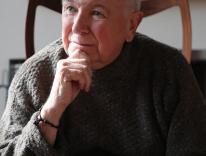 There’s an elusiveness to Jay Gatsby, the figure who haunts F. Scott Fitzgerald’s best-loved work. Gatsby is a charismatic millionaire who blends into the background at his own lavish parties. He is glamorous and yet pathetic, self-inventing but helpless. His smile radiates “eternal reassurance,” the book tells us, and his mind engenders and encompasses “a universe of ineffable gaudiness.” What actor, what director, could truly capture a character like that?
There’s an elusiveness to Jay Gatsby, the figure who haunts F. Scott Fitzgerald’s best-loved work. Gatsby is a charismatic millionaire who blends into the background at his own lavish parties. He is glamorous and yet pathetic, self-inventing but helpless. His smile radiates “eternal reassurance,” the book tells us, and his mind engenders and encompasses “a universe of ineffable gaudiness.” What actor, what director, could truly capture a character like that?
Probably none—and therein lies the brilliance of Gatz, the six-and-a-half-hour dramatization of The Great Gatsby by New York’s edgy theater company Elevator Repair Service. In mounting this production, which includes every single word of Fitzgerald’s text, and which is directed by John Collins, the troupe doesn’t aim to channel, or even approximate, the 1925 novel. Instead, the show turns a series of oddball contemporary images into a sounding board that resonates with the novel’s observations and with our own reactions to them.
In performance at New York’s Public Theater through May 13 (it will visit London in June and July), Gatz unfurls on a set that looks like the headquarters of a woebegone modern nonprofit. Ugly fluorescent lights glare on metal desks, a battered sofa, metal filing cabinets and bookshelves crammed with cardboard storage boxes. When a balding man tramps resignedly into this environment, draping his trenchcoat over a tripod that serves as a coat rack, it’s obvious that he is an unenthusiastic working stiff. Sure enough, he sits down at a computer terminal that appears to predate the internet. Waiting for the system to boot up, he flips open a plastic Rolodex and finds, to his evident astonishment, a paperback copy of The Great Gatsby. Hesitantly, he reads the opening sentences aloud. His tone grows more animated, and gradually our balding nine-to-fiver (Scott Shepherd) turns into Nick Carraway, the narrator of the novel.
Subsequent figures who putter into the office take on the novel’s other characters, but that doesn’t mean the play’s action shifts to the 1920s: twenty--first-century bureaucracy still plods around and through Fitzgerald’s story. When he’s not intoning Gatsby’s lines in a slightly deadpan voice, actor Jim Fletcher may be pecking at a typewriter, or taking a phone call. Other characters sort mail, file documents, or shuffle paperwork, and at one point someone wanders blankly past a window eating Lay’s potato chips. The clothing is contemporary, and the props are Staples-caliber objects standing in for Jazz Age trappings. (Louisa Thompson designed the set and Colleen Werthmann the costumes.) When the Gatsby character Tom Buchanan (a suitably loutish Gary Wilmes) and his mistress Myrtle (Laurena Allan) throw a chaotic party, papers scattered from a desk evoke the Prohibition-era bacchanal.
The obvious discrepancy between the stage picture and the novel’s vision helps derail the mindset of anxious reverence that a theatergoer (especially one who studied Gatsby in school) might otherwise bring to the show. For instance, when Fletcher appears in a pink jacket, looking flamboyantly dorky, you’re able to laugh at the hard-to-grasp idea of Gatsby’s allure. (The show takes its title, of course, from Jay Gatsby’s birth name, James Gatz.) The lampooning of the character of Jordan Baker, Nick’s golf-champion girlfriend, does seem over-the-top—at one point, actress Susie Sokol, with the air of a modern slacker, plops herself down on the sofa to read Golf Magazine. But in general, the show’s gentle spoofing of the Gatsby mystique helps you experience the book afresh.
That means getting another look at some themes that suddenly feel timely again. Set as it is in the Roaring Twenties—the lead-up to the Great Depression—Fitzgerald’s tale seems to foreshadow our own era’s housing bubble and subsequent economic meltdown. The descriptions of Gatsby’s parties and Tom Buchanan’s polo ponies seem to point toward current income disparities and the Occupy Wall Street movement. Who are Gatsby and the Buchanans if not the One Percent?
Admittedly, ERS launched Gatz before our recent financial doldrums: the company began taking the piece through Europe and to certain U.S. cities as early as 2006. But because a more conventional and commercial Gatsby dramatization was aiming for Broadway (it never arrived), the Fitzgerald estate initially prohibited New York performances of Gatz.
The piece finally had its official Big Apple debut in 2010, and positive response prompted the Public to schedule this return engagement. The Public is an apt venue for the piece: sitting in the audience, you can hear New York street noise and feel the subway rocketing by. You see the dreary office on the stage as a more exotic Jazz Age saga unspools in your mind. Nick Carraway wrote of glimpsing “the inexhaustible variety of life”: Gatz allows you to share that perception.
Please email comments to [email protected] and join the conversation on our Facebook page.
Previous Story
Bees' work
Next Story
Aristo Antics

